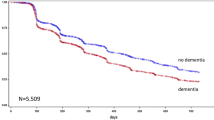Abstract
Polypharmacy as well as urinary incontinence are common geriatric problems. Possible adverse drug effects remain a matter of concern in geriatric medicine and must be considered in urinary incontinence. The occurrence or aggravation of lower urinary tract symptoms might be caused by medication, especially when the symptom is newly diagnosed. On the other hand geriatric patients are at an increased risk for adverse effects of medications, commonly used for treatment of urinary incontinence. Especially antimuscarinic drugs reveal several complex anticholinergic adverse effects. Therefore, knowledge of inappropriate medication and of possible adverse drug effects is important in the diagnostic evaluation and therapeutic considerations to prevent a cascade of symptom-related medications.
Zusammenfassung
Polypharmazie wie auch Inkontinenzleiden stellen häufige geriatrische Probleme dar. Nicht selten können sich beide Konditionen gegenseitig beeinflussen und verstärken. Harninkontinenz kann in manchen Fällen ein Hinweis für eine Medikamentennebenwirkung sein. Andererseits können Medikamente, in erster Linie Anticholinergika, die in der Therapie von Inkontinenzleiden eingesetzt werden, bei geriatrischen Patienten schwere unerwünschte Medikamentennebenwirkungen und -interaktionen verursachen. Grund dafür sind veränderte pharmakokinetische und pharmakodynamische Eigenschaften. Daher muss bei diesen Patienten sowohl bei der Evaluierung als auch in der Therapie von Inkontinenzsymptomen ein besonderes Augenmerk auf mögliche Medikamentennebenwirkungen und -interaktionen gelegt werden.
Similar content being viewed by others
References
Asplund R, Aberg H (1991) Diurnal variation in the levels of antidiuretic hormone in the elderly. J Intern Med 229(2):131–134
Beers MH, Ouslander JG, Rollingher I et al (1991) Explicit criteria for determining inappropriate medication use in nursing home residents. UCLA Division of Geriatric Medicine. Arch Intern Med 151(9):1825–1832
Boudreau DM, Yu O, Gray SL et al (2009) Concomitant use of cholinesterase inhibitors and anticholinergics: prevalence and outcomes. J Am Geriatr Soc 57:1238–1244
Callaway E, Halliday R, Naylor H (1992) Cholinergic activity and constraints on information processing. Biol Psychol 33:1–22
Chapple CR, Khullar V, Gabriel Z et al (2008) The effects of antimuscarinic treatments in overactive bladder: an update of a systematic review and meta-analysis. Eur Urol 54:543–562
Cigolle CT, Langa KM, Kabeto MU et al (2007) Geriatric conditions and disability: the Health and Retirement Study. Ann Intern Med 147:156–164
DuBeau CE, Kuchel GA, Johnson T et al (2009) Incontinence in the frail elderly. In: Abrams P, Cardozo L, Khoury S, Wein A (eds) 4th International Consultation on Incontinence. Recommendations of the International Scientific Committee: Evaluation and Treatment of Urinary Incontinence, Pelvic Organ Prolapse and Faecal Incontinence. 4th ed. Health Publication Ltd, Paris, pp 961–1024
Gallagher P, Ryan C, Byrne S et al (2008) STOPP (Screening Tool of Older Person’s Prescriptions) and START (Screening Tool to Alert doctors to Right Treatment). Consensus validation. Int J Clin Pharmacol Ther 46(2):72–83
Gill SS, Mamdani M, Naglie G et al (2005) A prescribing cascade involving cholinesterase inhibitors and anticholinergic drugs. Arch Intern Med 165:808
Hogan DB (1997) Revisiting the O complex: urinary incontinence, delirium and polypharmacy in elderly patients. CMAJ 157(8):1071–1077
Holroyd-Leduc JM, Mehta KM, Covinsky KE (2004) Urinary incontinence and its association with death, nursing home admission, and functional decline. J Am Geriatr Soc 52:712–718
Holt S, Schmiedl S, Thürmann PA (2010) Potentially inappropriate medications in the elderly: the PRISCUS list. Dtsch Ärztebl 107:543–551
Kessler TM, Bachmann LM, Minder C et al (2011) Adverse event assessment of antimuscarinics for treating overactive bladder: a network meta-analytic approach. PLoS ONE 6(2):e16718. doi: 10.1371/journal.pone.0016718
Laroche ML, Charmes JP, Merle L (2007) Potentially inappropriate medications in the elderly: a French consensus panel list. Eur J Clin Pharmacol 63:725–731
Madhuvrata P, Cody JD, Ellis G et al (2012) Which anticholinergic drug for overactive bladder symptoms in adults. Cochrane Database Syst Rev 1:CD005429
Milsom I, Altman D, Lapitan MC et al (2009) Epidemiology of urinary and faecal incontinence and pelvic organ prolapse. In: Abrams P, Cardozo L, Khoury S, Wein A (eds) 4th International Consultation on Incontinence. Recommendations of the International Scientific Committee: Evaluation and Treatment of Urinary Incontinence, Pelvic Organ Prolapse and Faecal Incontinence. 4th ed. Health Publication Ltd., Paris, France, pp 35–111
Modi A, Weiner M, Craig BA et al (2009) Concomitant use of anticholinergics with acetylcholinesterase inhibitors in Medicaid recipients with dementia and residing in nursing homes. J Am Geriatr Soc 57:1238
Novara G, Galfano A, Secco S et al (2008) A systematic review and meta-analysis of randomized controlled trials with antimuscarinic drugs for overactive bladder. Eur Urol 54(4):740–764
Österreichisches Basisassessment. http://www.geriatrie-online.at. Accessed 12 June 2012
Ouslander JG, Johnson TM (1998) Incontinence. In: Hazzard WR, Blass JP, Ettinger WH et al (eds) Principles of Geriatric Medicine and Gerontology. 4th Ed. McGraw-Hill, New York, pp 1595–1613
Ouslander JG et al (1998) Arginine vasopressin levels in nursing home residents with nighttime urinary incontinence. J Am Geriatr Soc 46:1274–1279
Mann E, Böhmdorfer B, Frühwald T et al (2012) Potentially inappropriate medication in geriatric patients: the Austrian consensus panel list. Wien Klin Wochenschr 124(5–6):160–169
Robinson D, Cardozo L (2012) Antimuscarinic drugs to treat overactive bladder. BMJ 344:e2130. doi:10.1136/bmj.e2130
The American Geriatrics Society 2012 Beers Criteria Update Expert Panel (2012) AGS updated Beers Criteria for potentially inappropriate medication use in older adults. J Am Geriatr Soc 60(4):616–631
Kerrebroeck P van et al (2002) The standardisation of terminology in nocturia: report from the Standardisation Sub-committee of the International Continence Society. Neurourol Urodyn 21:179–183
Weiss JP, Blaivas JG, Bliwise DL et al (2011) The evaluation and treatment of nocturia: a consensus statement. BJU Int 108:6–21
Woodford H, George J (2007) NICE guidelines on urinary incontinence in women. Age Ageing 36:349–350
Conflict of interest
On behalf of all authors, the corresponding author states that there are no conflicts of interest.
Author information
Authors and Affiliations
Corresponding author
Rights and permissions
About this article
Cite this article
Talasz, H., Lechleitner, M. Polypharmacy and incontinence. Z Gerontol Geriat 45, 464–467 (2012). https://doi.org/10.1007/s00391-012-0358-7
Published:
Issue Date:
DOI: https://doi.org/10.1007/s00391-012-0358-7




